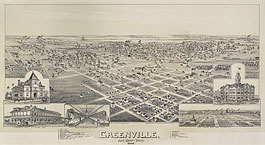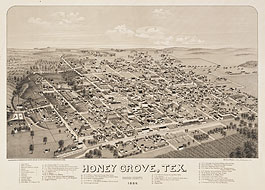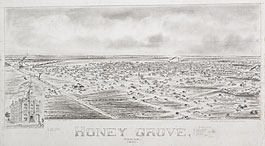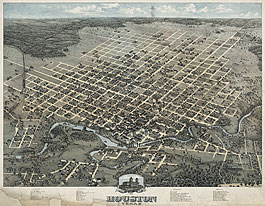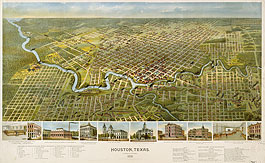Greenville in 1891
For a city that waited longer than most for the railroad, Greenville had become a rail center by the time of Fowler’s visit in 1891. In addition to the Missouri, Kansas and Texas, the East Line and Red River, and the Dallas and Greenville railways, the St. Louis Southwestern arrived in 1887 and the Texas Midland in 1896, five years after Fowler’s view. Hunt County was no longer an… [More]
Honey Grove in 1886
Traveling eastward, probably on the Texas and Pacific Railroad, Wellge continued his tour of North Texas with a visit to Honey Grove, a little more than forty miles from Denison. The city got its name from a nearby grove of trees, where the early settlers found an apiary. The arrival of the T&P in 1873 had turned the village of about 300 persons into a small, regional center with… [More]
Honey Grove in 1891
Fowler included Honey Grove in his 1891 tour of North Texas and produced an elaborate drawing of the city, highlighted with blue pencil and wash, but there is no record that it was ever lithographed. Perhaps the economic situation had worsened for Honey Grove merchants and farmers since Henry Wellge’s 1886 visit; or perhaps they believed that Wellge’s handsome lithograph had not paid sufficient dividends and were unwilling to… [More]
Houston in 1873
Shortly after Texas won its independence on the nearby battlefield at San Jacinto in 1836, Augustus C. and John K. Allen founded Houston at the head of tide on Buffalo Bayou to be the leading metropolis of the new nation. Sam Houston, elected first president of the Republic of Texas, was honored to have the city named after him and considered the site “far superior” to all others for… [More]
Houston in 1891
A. L. Westyard’s view of Houston in 1891 documented the city as it began a decade of explosive growth—in population, growing from 27,557 in 1890 to 44,633 in 1900, as well as in area, with suburbs such as Magnolia Park appearing beyond the jurisdictional reach of the City Council but made convenient to the city center by rail transportation. Houston in the 1890s came face-to-face with the advantages and… [More]











